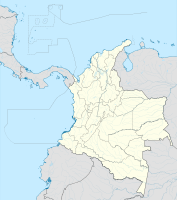Pamplona (Colombia)
| Pamplona | ||
|---|---|---|
|
Coordinates: 7 ° 23 ′ N , 72 ° 39 ′ W Pamplona on the map of Colombia
|
||
|
Location of the municipality of Pamplona on the map of Norte de Santander
|
||
| Basic data | ||
| Country | Colombia | |
| Department | North of Santander | |
| City foundation | 1549 | |
| Residents | 58,975 (2019) | |
| City insignia | ||
| Detailed data | ||
| surface | 1342 km 2 | |
| Population density | 44 people / km 2 | |
| height | 2287 m | |
| Time zone | UTC -5 | |
| City Presidency | Ronald Mauricio Contreras Flórez (2016-2019) | |
| Website | ||
| View of Pamplona | ||
Pamplona is a municipality ( municipio ) in the department of Norte de Santander (northeast Colombia ). Pamplona is the seat of the Archdiocese of Nueva Pamplona and the University of Pamplona .
geography
Pamplona is located in the Departamento de Norte de Santander at an altitude of 2200 m above sea level. NN , 75 km from Cúcuta and 124 km from Bucaramanga and has an average temperature of 16 ° C. The municipality is bordered to the north by Pamplonita and Cucutilla , to the south Cácota and Mutiscua , on the east by Labateca and to the west Cucutilla.
population
The municipality of Pamplona has 58,975 inhabitants, of which 56,267 live in the urban part (cabecera municipal) of the municipality (as of 2019).
history
Pamplona was founded on November 1st, 1549 by Pedro de Ursúa and Ortún Velasco de Velásquez as Nueva Pamplona del Valle del Espíritu Santo ( New Pamplona of the Valley of the Holy Spirit ). New Pamplona was the starting point for various city foundations in the area, including a. Mérida, San Cristóbal and La Grita in neighboring Venezuela , as well as Ocaña, Salazar de las Palmas, Chinácota, San Faustino, Bucaramanga and San José de Cúcuta in Colombia .
The natives of the area, called Chitareros by the Spaniards , were forced by the colonizers to work in the 53 homesteads of the territory from 1549.
In 1875 an earthquake destroyed the cathedral and other public buildings.
Attractions
- In Águeda Gallardo Park , in the city center, there are numerous buildings from the colonial era.
- The cathedral was built as the church of the St. Clare Monastery in 1584 at the instigation of Magdalena Velasco, the daughter of the city's founder
- The sanctuary of Humilladero was the place of activity of a hermit in the founding years of the city.
- The archbishop's palace used to be the seat of the noble Rangel de Cuellar family. It has been the seat of the archbishops since 1837.
economy
As a university city, Pamplona has a dynamic economy. The students must be accommodated and cared for. There are many restaurants, bars and hotels. Agriculture , especially the cultivation of potatoes and animal husbandry, play an important role in the rural part of the municipality .
Web links
- Alcaldia de Pamplona. Alcaldía de Pamplona - Norte de Santander, accessed April 9, 2019 (Spanish, municipality website).
Individual evidence
- ^ Información del municipio. Alcaldía de Pamplona - Norte de Santander, accessed April 9, 2019 (Spanish, information on the geography of the municipality).
- ↑ ESTIMACIONES DE POBLACIÓN 1985 - 2005 Y PROYECCIONES DE POBLACIÓN 2005 - 2020 TOTAL DEPARTAMENTAL POR ÁREA. (Excel; 1.72 MB) DANE, May 11, 2011, accessed on April 9, 2019 (Spanish, extrapolation of the population of Colombia).
- ↑ Pasado, presente y futuro. Alcaldía de Pamplona - Norte de Santander, accessed April 9, 2019 (Spanish, information on the history of the municipality).
- ↑ Economía. Alcaldía de Pamplona - Norte de Santander, accessed April 9, 2019 (Spanish, information on the municipality's economy).





